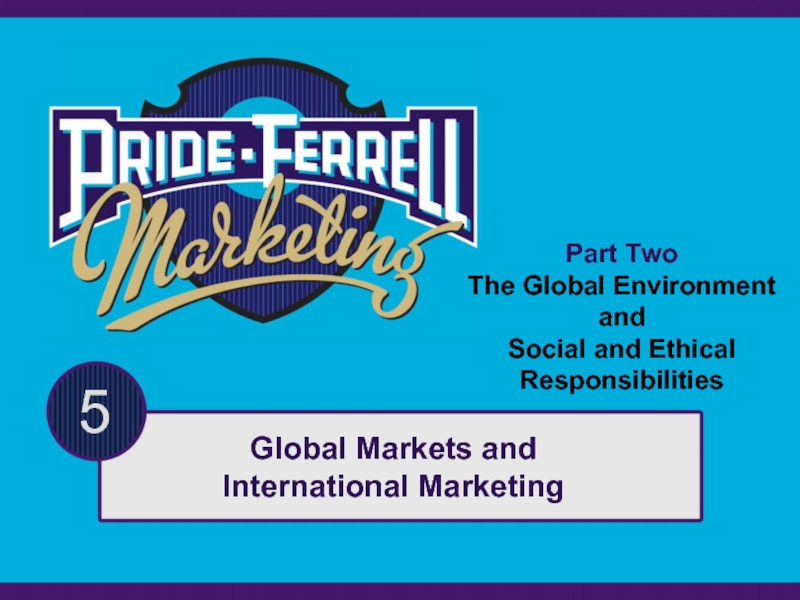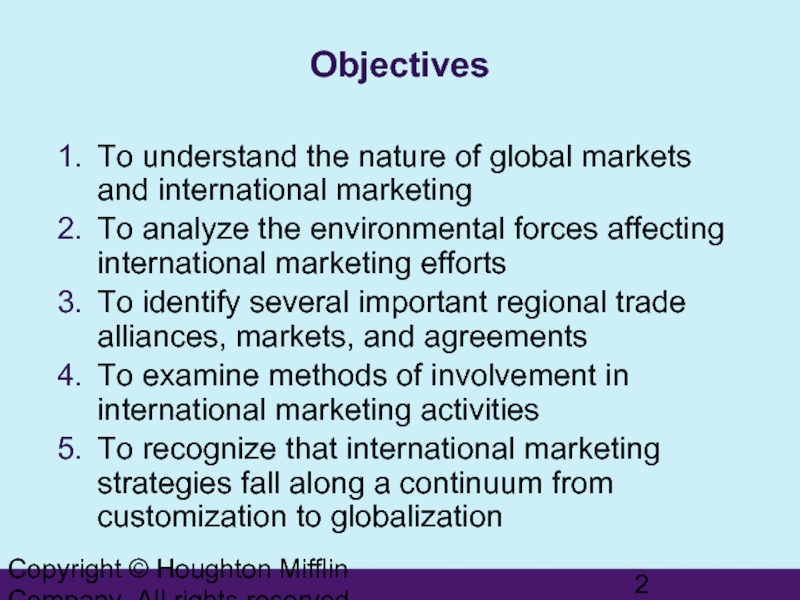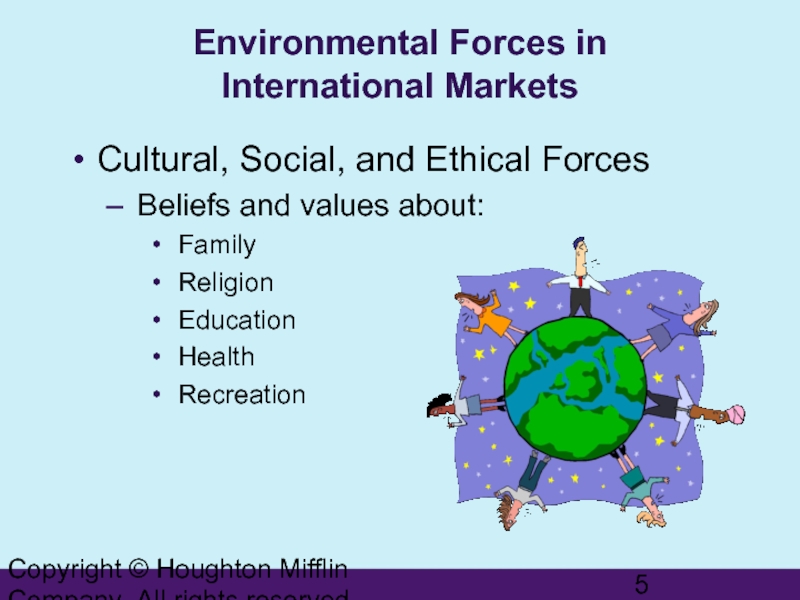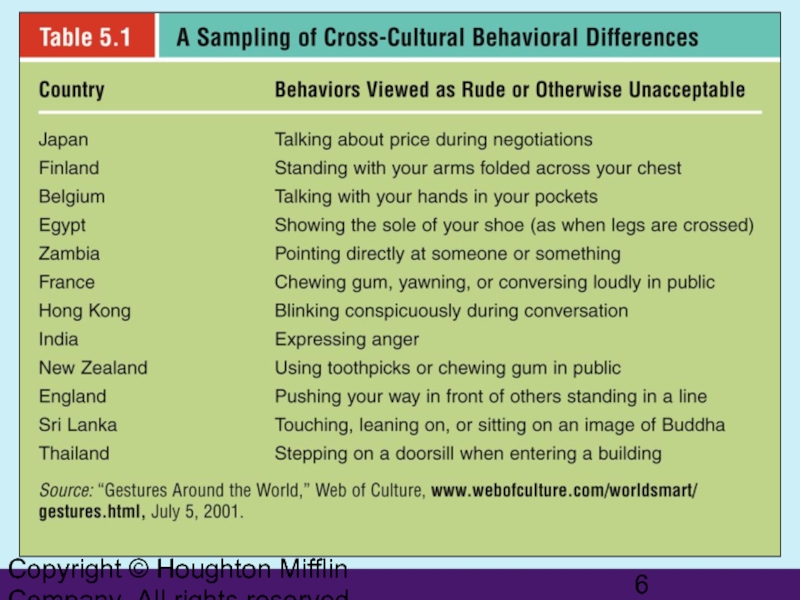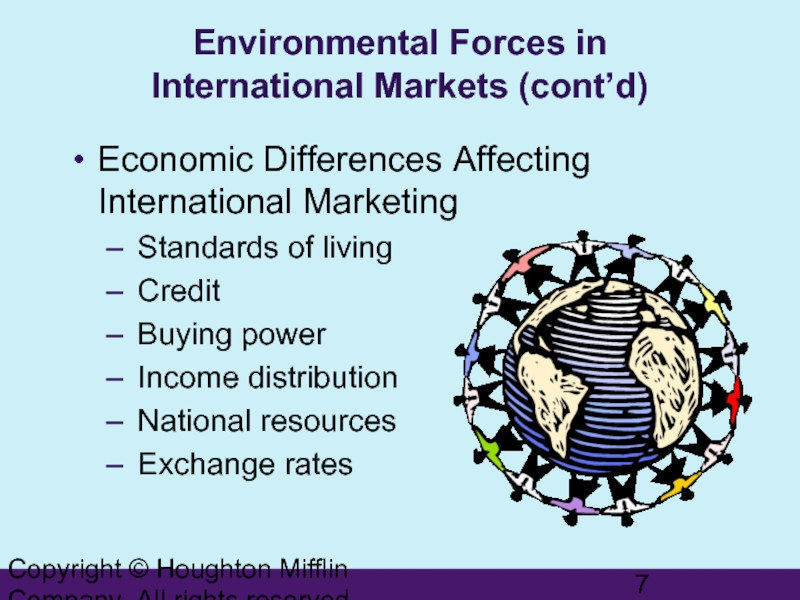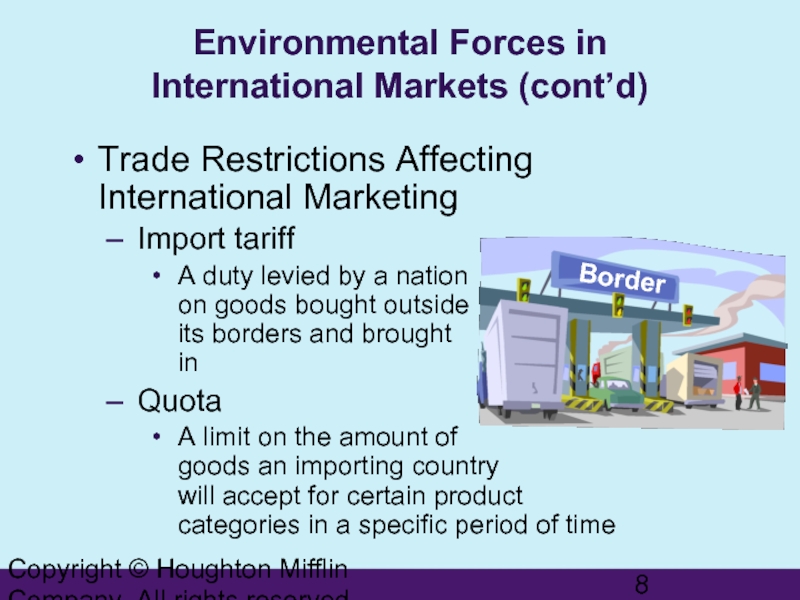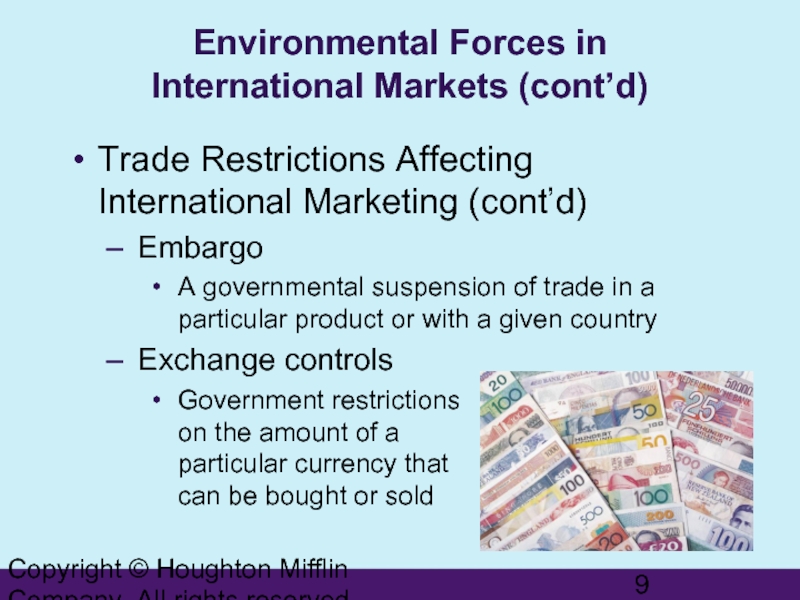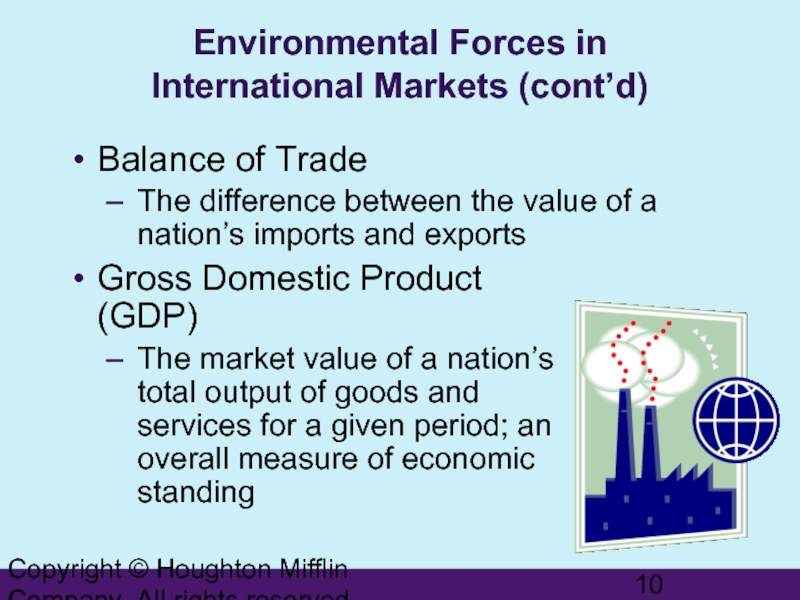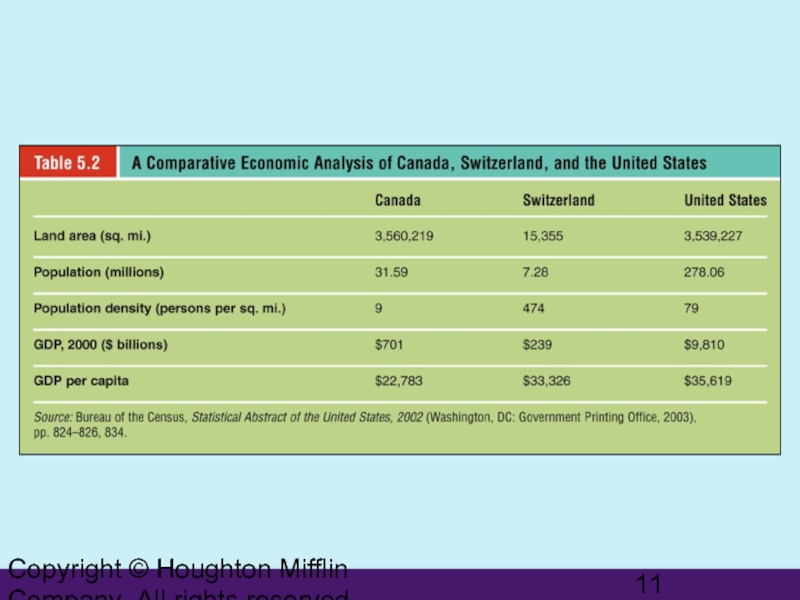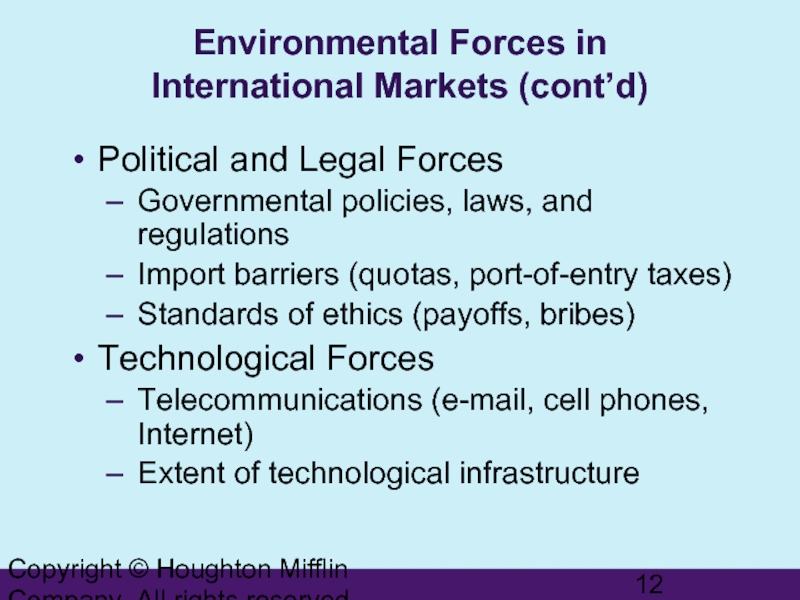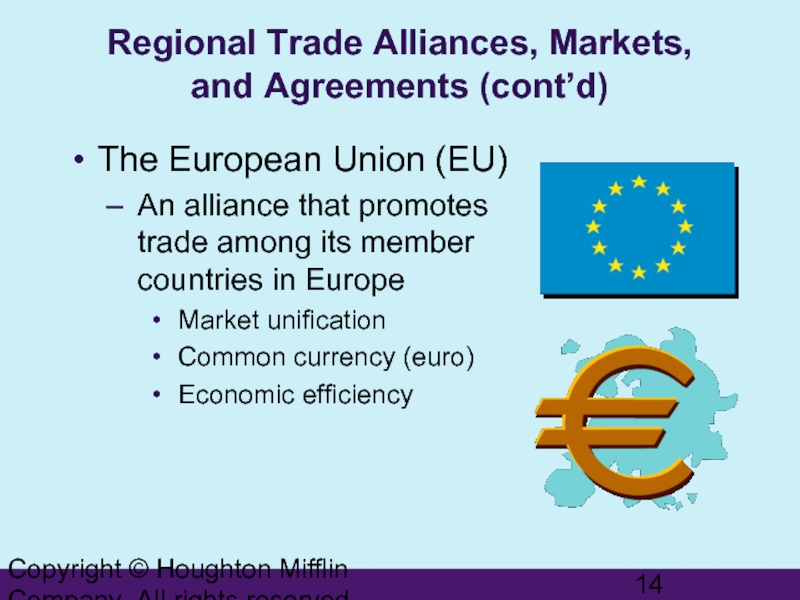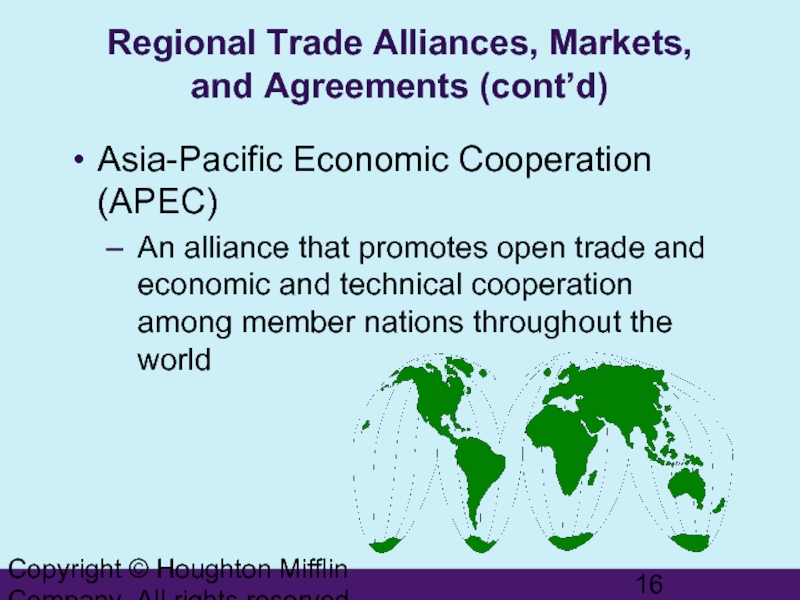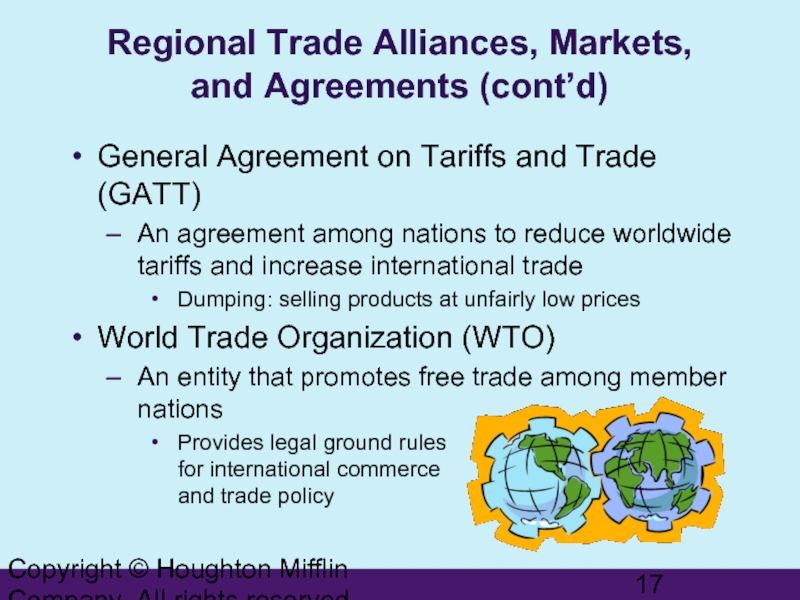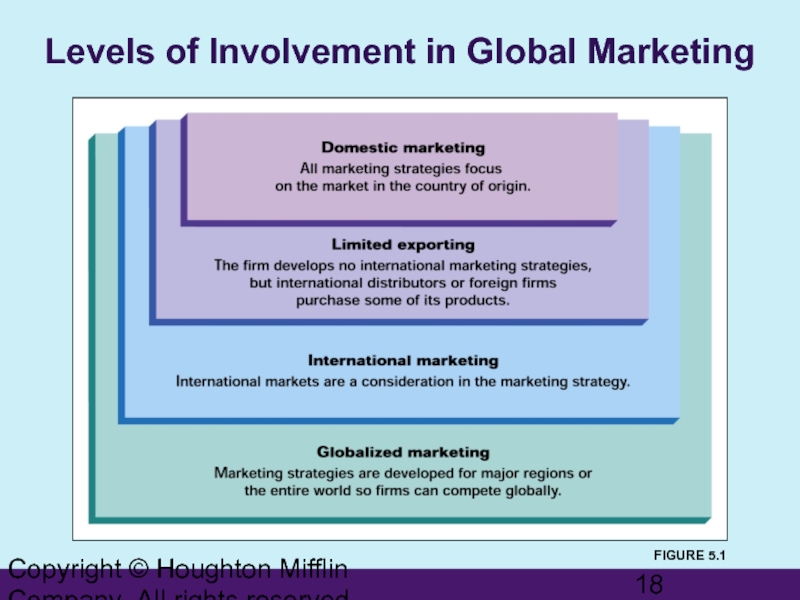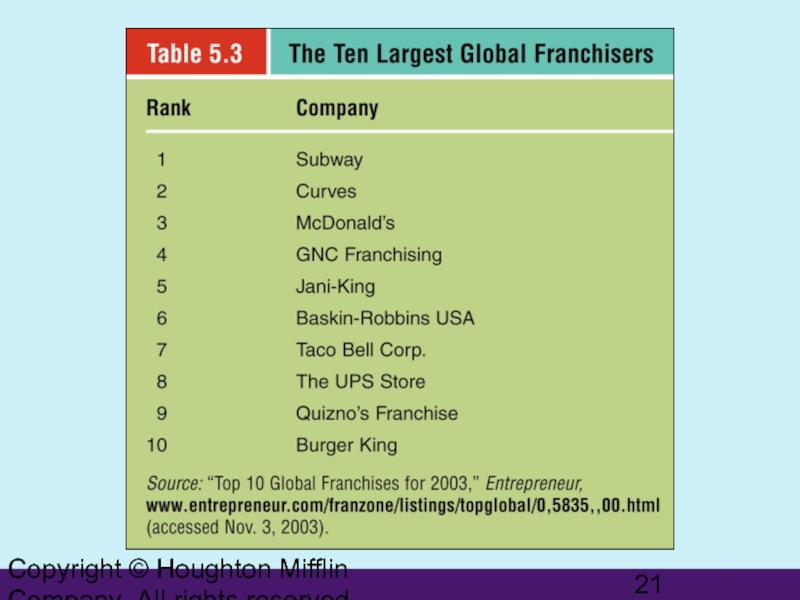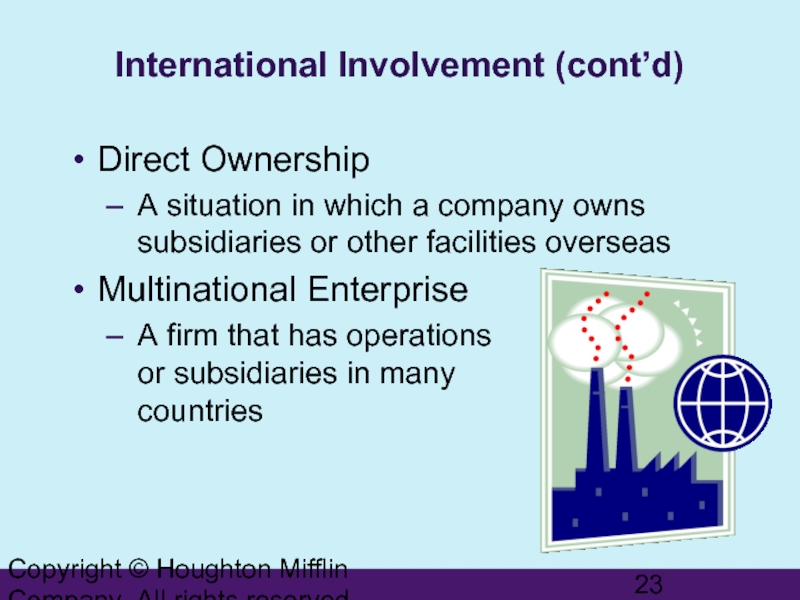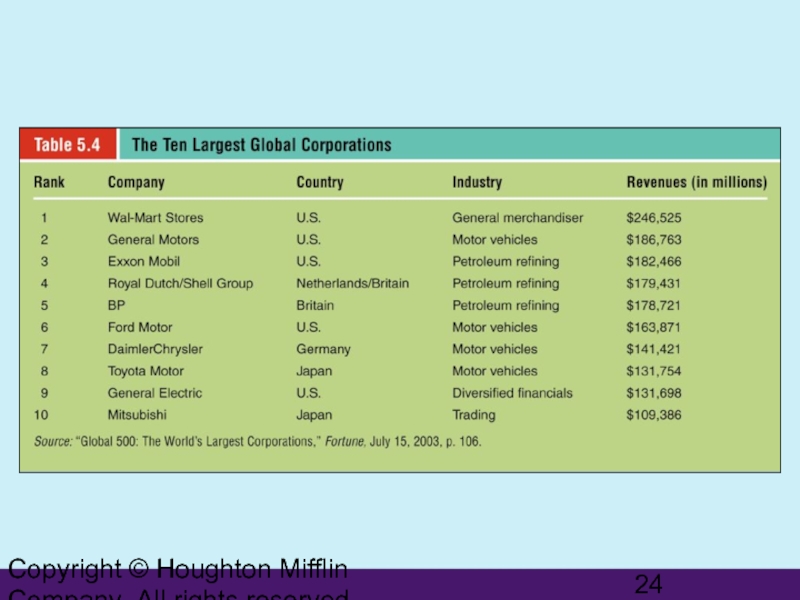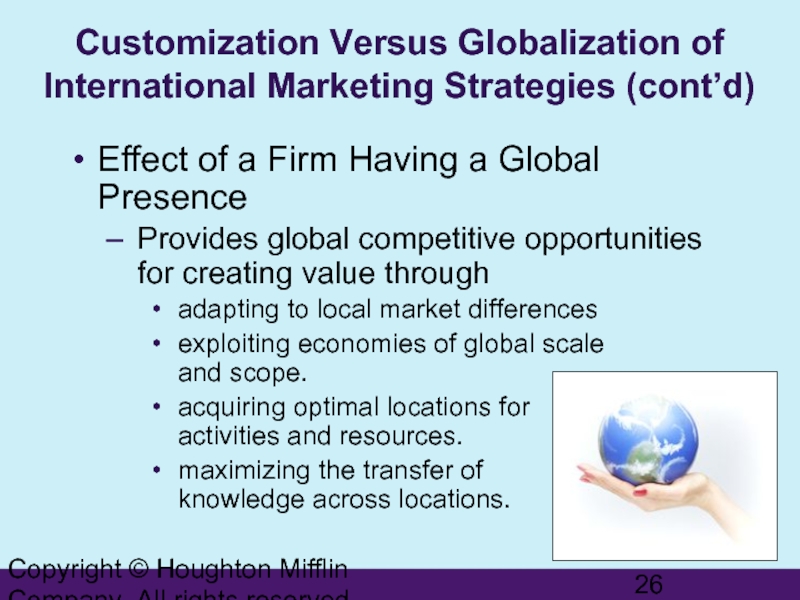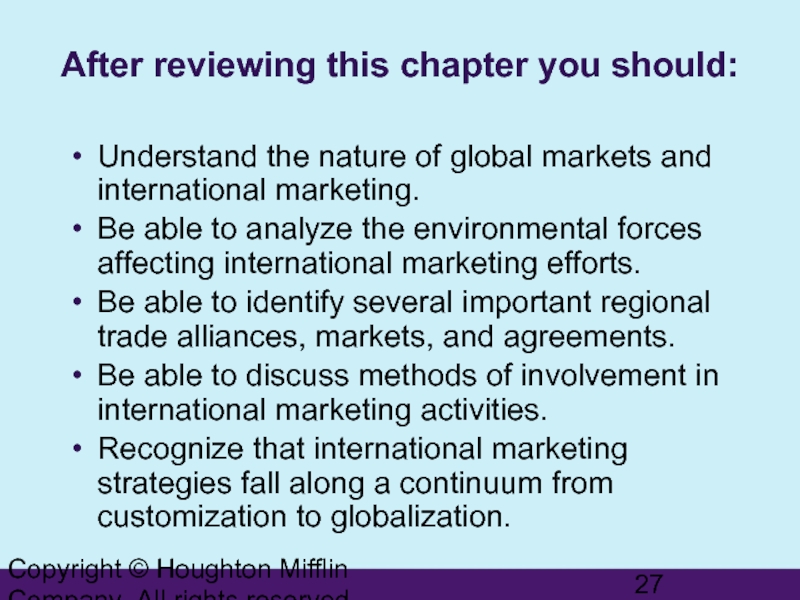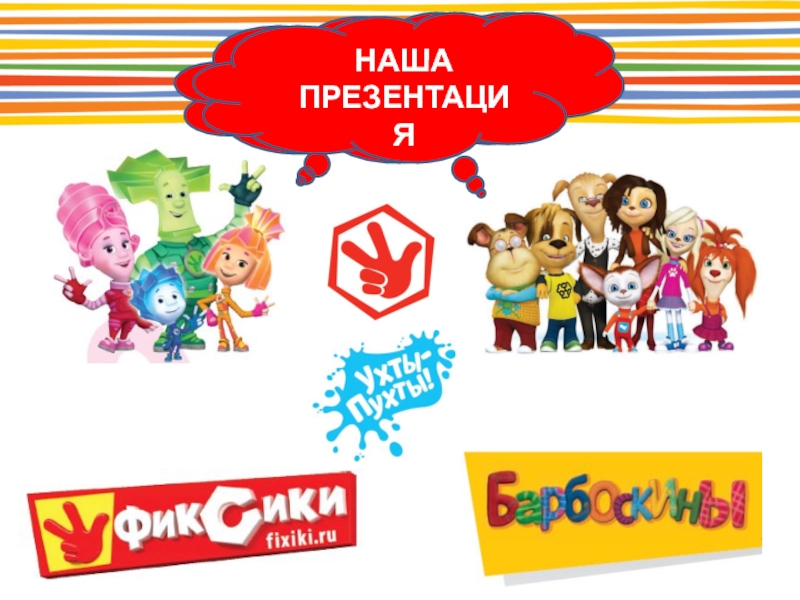- Главная
- Разное
- Дизайн
- Бизнес и предпринимательство
- Аналитика
- Образование
- Развлечения
- Красота и здоровье
- Финансы
- Государство
- Путешествия
- Спорт
- Недвижимость
- Армия
- Графика
- Культурология
- Еда и кулинария
- Лингвистика
- Английский язык
- Астрономия
- Алгебра
- Биология
- География
- Детские презентации
- Информатика
- История
- Литература
- Маркетинг
- Математика
- Медицина
- Менеджмент
- Музыка
- МХК
- Немецкий язык
- ОБЖ
- Обществознание
- Окружающий мир
- Педагогика
- Русский язык
- Технология
- Физика
- Философия
- Химия
- Шаблоны, картинки для презентаций
- Экология
- Экономика
- Юриспруденция
The global environment and social and ethical responsibilities. Global markets and international marketing презентация
Содержание
- 1. The global environment and social and ethical responsibilities. Global markets and international marketing
- 2. Copyright © Houghton Mifflin Company. All rights
- 3. Copyright © Houghton Mifflin Company. All rights
- 4. Copyright © Houghton Mifflin Company. All rights
- 5. Copyright © Houghton Mifflin Company. All rights
- 6. Copyright © Houghton Mifflin Company. All rights reserved.
- 7. Copyright © Houghton Mifflin Company. All rights
- 8. Copyright © Houghton Mifflin Company. All rights
- 9. Copyright © Houghton Mifflin Company. All rights
- 10. Copyright © Houghton Mifflin Company. All rights
- 11. Copyright © Houghton Mifflin Company. All rights reserved.
- 12. Copyright © Houghton Mifflin Company. All rights
- 13. Copyright © Houghton Mifflin Company. All rights
- 14. Copyright © Houghton Mifflin Company. All rights
- 15. Copyright © Houghton Mifflin Company. All rights
- 16. Copyright © Houghton Mifflin Company. All rights
- 17. Copyright © Houghton Mifflin Company. All rights
- 18. Copyright © Houghton Mifflin Company. All rights
- 19. Copyright © Houghton Mifflin Company. All rights
- 20. Copyright © Houghton Mifflin Company. All rights
- 21. Copyright © Houghton Mifflin Company. All rights reserved.
- 22. Copyright © Houghton Mifflin Company. All rights
- 23. Copyright © Houghton Mifflin Company. All rights
- 24. Copyright © Houghton Mifflin Company. All rights reserved.
- 25. Copyright © Houghton Mifflin Company. All rights
- 26. Copyright © Houghton Mifflin Company. All rights
- 27. Copyright © Houghton Mifflin Company. All rights
Слайд 2Copyright © Houghton Mifflin Company. All rights reserved.
Objectives
To understand the nature
To analyze the environmental forces affecting international marketing efforts
To identify several important regional trade alliances, markets, and agreements
To examine methods of involvement in international marketing activities
To recognize that international marketing strategies fall along a continuum from customization to globalization
Слайд 3Copyright © Houghton Mifflin Company. All rights reserved.
Chapter Outline
The Nature of
Environmental Forces in International Markets
Regional Trade Alliances, Markets, and Agreements
International Involvement
Customization Versus Globalization of International Marketing Strategies
Слайд 4Copyright © Houghton Mifflin Company. All rights reserved.
The Nature of International
International Marketing
Developing and performing marketing activities across national boundaries
Provides growth opportunities
Promotes innovation
Fosters marketing of better,
less expensive products
Слайд 5Copyright © Houghton Mifflin Company. All rights reserved.
Environmental Forces in
International
Cultural, Social, and Ethical Forces
Beliefs and values about:
Family
Religion
Education
Health
Recreation
Слайд 7Copyright © Houghton Mifflin Company. All rights reserved.
Environmental Forces in
International
Economic Differences Affecting International Marketing
Standards of living
Credit
Buying power
Income distribution
National resources
Exchange rates
Слайд 8Copyright © Houghton Mifflin Company. All rights reserved.
Environmental Forces in
International
Trade Restrictions Affecting International Marketing
Import tariff
A duty levied by a nation
on goods bought outside
its borders and brought
in
Quota
A limit on the amount of
goods an importing country
will accept for certain product
categories in a specific period of time
Слайд 9Copyright © Houghton Mifflin Company. All rights reserved.
Environmental Forces in
International
Trade Restrictions Affecting International Marketing (cont’d)
Embargo
A governmental suspension of trade in a particular product or with a given country
Exchange controls
Government restrictions
on the amount of a
particular currency that
can be bought or sold
Слайд 10Copyright © Houghton Mifflin Company. All rights reserved.
Environmental Forces in
International
Balance of Trade
The difference between the value of a nation’s imports and exports
Gross Domestic Product
(GDP)
The market value of a nation’s
total output of goods and
services for a given period; an
overall measure of economic
standing
Слайд 12Copyright © Houghton Mifflin Company. All rights reserved.
Environmental Forces in
International
Political and Legal Forces
Governmental policies, laws, and regulations
Import barriers (quotas, port-of-entry taxes)
Standards of ethics (payoffs, bribes)
Technological Forces
Telecommunications (e-mail, cell phones, Internet)
Extent of technological infrastructure
Слайд 13Copyright © Houghton Mifflin Company. All rights reserved.
Regional Trade Alliances, Markets,
The North American
Free Trade Agreement
(NAFTA)
An alliance that merges
Canada, Mexico, and the
United States into a single
market
Eliminates barriers
Eases investment
Simplifies trade
Слайд 14Copyright © Houghton Mifflin Company. All rights reserved.
Regional Trade Alliances, Markets,
The European Union (EU)
An alliance that promotes
trade among its member
countries in Europe
Market unification
Common currency (euro)
Economic efficiency
Слайд 15Copyright © Houghton Mifflin Company. All rights reserved.
Regional Trade Alliances, Markets,
The Common Market of the
Southern Cone (MERCOSUR)
An alliance that promotes
the free circulation of
goods, services, and
production factors, and
has a common external
tariff and commercial policy
among member nations in
South America
Слайд 16Copyright © Houghton Mifflin Company. All rights reserved.
Regional Trade Alliances, Markets,
Asia-Pacific Economic Cooperation (APEC)
An alliance that promotes open trade and economic and technical cooperation among member nations throughout the world
Слайд 17Copyright © Houghton Mifflin Company. All rights reserved.
Regional Trade Alliances, Markets,
General Agreement on Tariffs and Trade (GATT)
An agreement among nations to reduce worldwide tariffs and increase international trade
Dumping: selling products at unfairly low prices
World Trade Organization (WTO)
An entity that promotes free trade among member nations
Provides legal ground rules
for international commerce
and trade policy
Слайд 18Copyright © Houghton Mifflin Company. All rights reserved.
Levels of Involvement in
FIGURE 5.1
Слайд 19Copyright © Houghton Mifflin Company. All rights reserved.
International Involvement
Importing
The purchase of
Exporting
The sale of products to foreign markets
Trading Companies
Link buyers and sellers in different countries
Not involved in actual manufacture of products
Market and take title to goods to facilitate overseas exchange trading
Слайд 20Copyright © Houghton Mifflin Company. All rights reserved.
International Involvement (cont’d)
Licensing
An alternative
Franchising
A form of licensing in which the franchiser grants the franchisee the right to market its product in accordance with the franchiser’s standards
Слайд 22Copyright © Houghton Mifflin Company. All rights reserved.
International Involvement (cont’d)
Contract Manufacturing
Hiring
Joint Ventures
A partnership between a domestic firm and a foreign firm or government
Strategic alliance
A partnership formed to create a competitive advantage on a worldwide basis
Слайд 23Copyright © Houghton Mifflin Company. All rights reserved.
International Involvement (cont’d)
Direct Ownership
A
Multinational Enterprise
A firm that has operations or subsidiaries in many countries
Слайд 25Copyright © Houghton Mifflin Company. All rights reserved.
Customization Versus Globalization of
Customization
Adjusting marketing mixes according to cultural, regional, and national differences
Globalization
The development of marketing strategies that treat the entire world (or its major regions) as a single entity
Includes standardization of products, promotion campaigns, prices, and distribution channels
“Think globally, act locally”
Слайд 26Copyright © Houghton Mifflin Company. All rights reserved.
Customization Versus Globalization of
Effect of a Firm Having a Global Presence
Provides global competitive opportunities for creating value through
adapting to local market differences
exploiting economies of global scale
and scope.
acquiring optimal locations for
activities and resources.
maximizing the transfer of
knowledge across locations.
Слайд 27Copyright © Houghton Mifflin Company. All rights reserved.
After reviewing this chapter
Understand the nature of global markets and international marketing.
Be able to analyze the environmental forces affecting international marketing efforts.
Be able to identify several important regional trade alliances, markets, and agreements.
Be able to discuss methods of involvement in international marketing activities.
Recognize that international marketing strategies fall along a continuum from customization to globalization.
